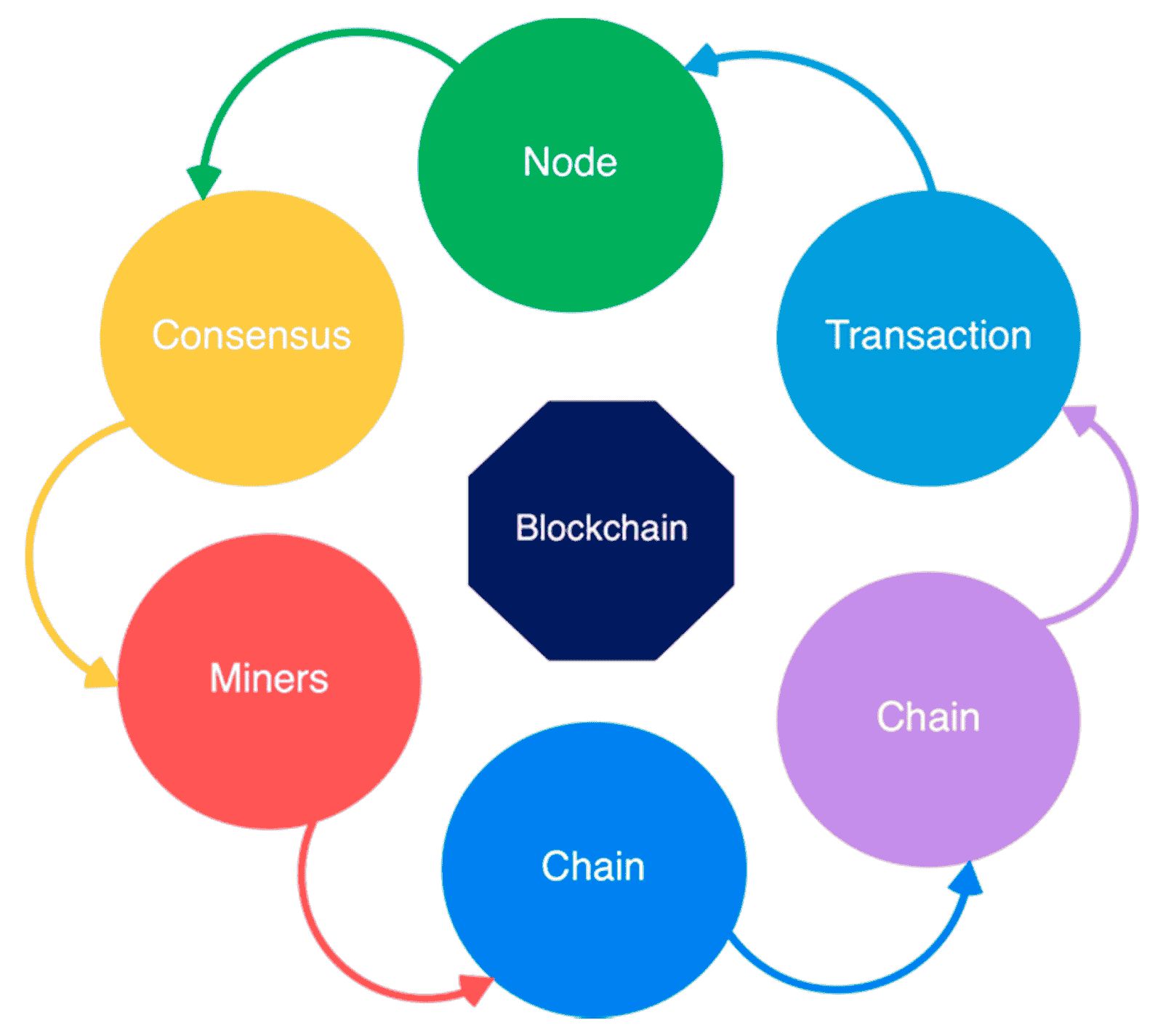Key Components of a Blockchain Network
Explore the foundational elements of a blockchain network, including decentralized nodes, consensus mechanisms, smart contracts, and cryptographic hash functions. Gain insights into how these key components work together to create a secure, transparent, and decentralized system for recording and validating transactions.

Blockchain, a decentralized transaction recording system, is gaining attention for its industry-altering potential. The foundation of this innovation rests on key components, constituting the essence of a blockchain network. These elements, including decentralized nodes, consensus mechanisms, smart contracts, cryptographic hash functions, and decentralized ledgers, collectively establish the framework for secure and transparent transactions, embodying the transformative nature of blockchain technology.
What is Blockchain Technology?
Blockchain technology is a decentralized and distributed ledger system that underlies cryptocurrencies like Bitcoin and has far-reaching applications beyond digital currencies. At its core, a blockchain is a chain of blocks, each containing a list of transactions. What sets it apart is its decentralized nature – instead of being stored in a central database, the blockchain is maintained by a network of computers, or nodes, spread across the globe. Each block is linked to the previous one through a cryptographic hash, creating a secure and unalterable chain. This transparency, security, and decentralization make blockchain a tamper-resistant and trust-enhancing technology. Beyond financial transactions, blockchain is being explored for applications in supply chain management, voting systems, healthcare, and more, promising increased efficiency, transparency, and security in various sectors.
Main Components of a Blockchain Network

When various components converge, they form a complex entity that guarantees "authentic privacy" and lays the groundwork for decentralized finance (De-Fi). Below, we'll delve into some essential blockchain components, accompanied by concise explanations for each.
1. Decentralized Nodes
2. Consensus Mechanism
3. Smart Contracts
4. Cryptographic Hash Functions
Decentralized Nodes
Decentralized nodes serve as the foundation of a blockchain network, embodying the core principle of decentralization. In this context, a node refers to an individual computer or device that actively participates in the blockchain network by maintaining a copy of the entire transaction history, or ledger. Unlike traditional centralized systems where a single authority controls data, decentralized nodes distribute this responsibility across a network of participants. Each node independently verifies and validates transactions, fostering a consensus mechanism that ensures agreement on the state of the ledger. This decentralization enhances the security, transparency, and resilience of the network, as no single point of failure exists. By distributing control among numerous nodes, a blockchain network becomes resistant to tampering and censorship, embodying a democratized and trustless approach to managing and recording transactions.
Consensus Mechanism
Blockchain technology, a consensus mechanism, serves as the critical protocol that ensures all participants within a decentralized network agree on the state of the system. The primary purpose of this mechanism is to validate transactions, enabling the network to reach a consensus on the order and validity of transactions without relying on a central authority.
Here are two common consensus mechanisms
Proof of Work (PoW)
PoW is one of the earliest and most well-known consensus mechanisms, notably used by Bitcoin. In a PoW system, participants, known as miners, compete to solve complex mathematical puzzles. The first miner to solve the puzzle broadcasts the solution to the network, and if verified, the proposed block is added to the blockchain. PoW is praised for its security due to the computational effort required to mine a block, but it comes with high energy consumption.
Proof of Stake (PoS)
PoS is an alternative consensus mechanism that addresses some of the environmental concerns associated with PoW. In a PoS system, validators are chosen to create new blocks based on the amount of cryptocurrency they hold and are willing to "stake" as collateral. This mechanism aims to reduce the need for extensive computational power, making it a more energy-efficient option.
The choice of consensus mechanism depends on the goals and priorities of a particular blockchain network. While PoW is known for its security but high energy consumption, PoS offers a more energy-efficient alternative. Other consensus mechanisms, such as Delegated Proof of Stake (DPoS) and Practical Byzantine Fault Tolerance (PBFT), cater to different use cases and priorities within the blockchain ecosystem.
Smart Contracts
Smart contracts are self-executing contracts with the terms of the agreement directly written into code. Unlike traditional contracts that rely on intermediaries such as lawyers or notaries to enforce terms, smart contracts operate autonomously on blockchain platforms. These digital contracts are designed to automatically execute, enforce, or verify the terms of an agreement when predefined conditions are met.
The key components of smart contracts include
Code: Smart contracts are written in programming languages specific to the blockchain platform they operate on. The code encapsulates the rules and conditions of the contract, defining how it will execute and what actions it will take based on various inputs.
Decentralized Execution: Smart contracts run on a decentralized network of computers (nodes) that validate and execute the code. This decentralized execution ensures that the contract is not controlled by a single entity, enhancing security, transparency, and trust.
Blockchain Integration: Smart contracts are typically deployed on blockchain platforms, and their code is stored in blocks across the distributed ledger. This integration with blockchain technology ensures immutability and transparency, as every participant on the network can verify the contract's execution and outcome.
Automated Triggering: Smart contracts are triggered by specific events or conditions, known as "if-then" statements. For example, if a certain date is reached, a payment is automatically released. This automation reduces the need for intermediaries and minimizes the risk of human error or fraud.
Trustless Execution: The decentralized and tamper-resistant nature of blockchain ensures the trustless execution of smart contracts. Participants can rely on the blockchain's integrity, knowing that the code will execute as programmed without the need for intermediaries or trust in a central authority.
Cryptographic Hash Functions
Cryptographic hash functions are foundational elements within the realm of blockchain technology, serving as crucial tools to ensure the integrity and security of data. These functions take input data of any size and produce a fixed-size string of characters, often referred to as a hash. The key characteristics of cryptographic hash functions contribute to the reliability and trustworthiness of blockchain networks:
Deterministic Output
A cryptographic hash function is deterministic, meaning that the same input will always produce the same output. This predictability is essential for verifying the consistency and accuracy of information within the blockchain.
Fixed Output Size
Regardless of the size or complexity of the input data, the output (hash) generated by the cryptographic hash function is of a fixed size. This feature is critical for standardization and compatibility within the blockchain network.
Irreversibility
Cryptographic hash functions are designed to be one-way functions, making it practically impossible to reverse-engineer the original input from the hash. This irreversibility ensures that the original data remains secure and confidential.
Collision Resistance
Collision resistance is a vital property of cryptographic hash functions, meaning that it should be extremely unlikely for two different inputs to produce the same hash. This feature enhances the security of the blockchain by minimizing the risk of fraudulent activities.
The key components of a blockchain network, including decentralized nodes, consensus mechanisms, smart contracts, and cryptographic hash functions, collectively embody the transformative power of this decentralized technology. By fostering transparency, security, and efficiency, these components pave the way for a new era of trustless transactions, promising to reshape industries beyond digital currencies and revolutionize the way we conduct and verify transactions across various sectors.




























































